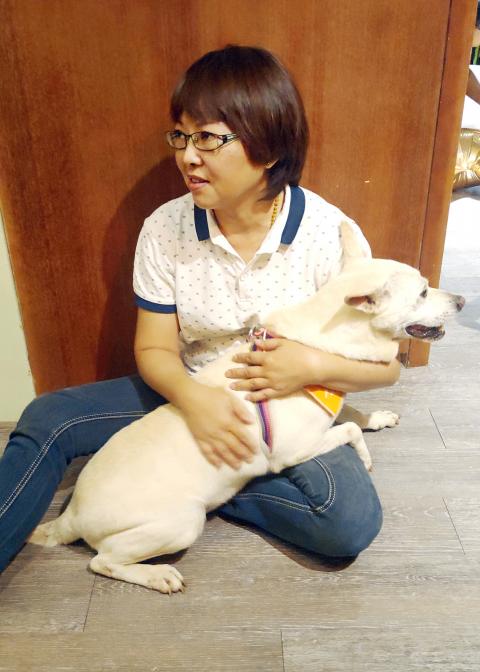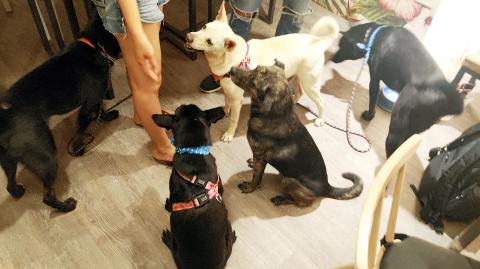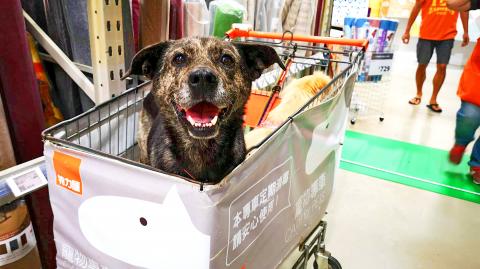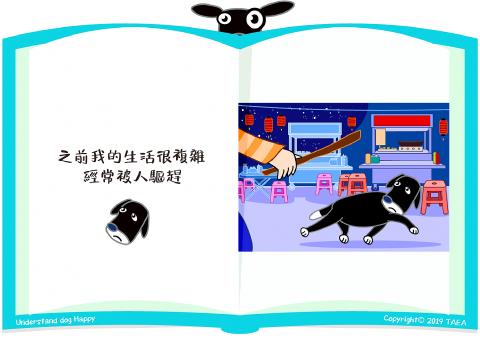When The PACK Sanctuary had two corgis dumped on them earlier this month, they were able to adopt them out in less than a week. For the remaining 300 or so mostly mixed-breed Taiwanese dogs at the shelter in New Taipei City’s Sanjhih District (三芝) though, the story isn’t so rosy.
With Taiwanese generally preferring to purchase smaller animals or trendy pooches such as red poodles, shibas and corgis, shelters around Taiwan are full of these mixed tugou (土狗), often black ones, as well as other less favorable breeds, that languish there year after year.
“We provide as much space and enrichment as we can, but with 300 dogs and so little resources, sadly the human-animal bond gets lost,” The Pack CEO Tim Gorski says. “Shelter life is not living; it’s existing.”

Photo courtesy of The Pack Sanctuary
When Taiwan Animal Equality Association (台灣動物平權促進會, TAEA) published an illustrated e-book earlier this year on treating a dog like it’s one of the family, it elected to feature a white-footed black tugou named “Happy” (黑皮) as its protagonist.
“We specifically wanted to feature the color combination that’s the hardest to adopt out due to traditional superstitions,” TAEA CEO Lin Yi-shan (林憶珊) says. “We wanted to let our audience know that these mixed-breed Taiwanese dogs are also very adorable.”
THE TUGOU PROBLEM

Photo: Han Cheung, Taipei Times
Most mixed tugous trace their lineage back to the Taiwan Dog, or Formosan Mountain Dog, who were used by Aborigines as hunting companions. Lee Chao-chuan (李朝全), chairman of the Animal Protection Association of the Republic of China (中華民國保護動物協會), says that as Taiwan’s economy took off in the 1950s, people started importing large foreign canines such as golden retrievers and German shepherds.
This problem persists today, where people tend to buy whatever dog breed is popular at the moment without considering whether they can care for the dog or whether the dog is suited to Taiwan’s environment. Due to a lack of pet care and ownership awareness, people do not know how to handle or train their best friend and often end up abandoning it.
Over the years, these numerous abandoned or escaped dogs crossbred with the Taiwan Dog, leading to the proliferation of mixed breed tugous that are common today. In fact, it’s hard to find a purebred Taiwan Dog these days, Lee says.

Photo: Han Cheung, Taipei Times
Besides the stereotypical perception of them as dirty, disease-infested street animals, another reason they’re not popular is that they’re too large for the typical urban Taiwanese household and need a great deal of exercise and care.
“Taiwanese don’t like the color black, so black mixes are especially unfavorable,” Lee adds.
“Red is auspicious, for example, so people like red poodles. They are also less aggressive.”

Photo courtesy of The Pack Sanctuary
Liu Su-fen (劉素芬), founder of Precious Dogs Association (寶貝狗協會) says that in fact, mixed-breed dogs are generally healthier than purebred dogs, many of whom have various congenital health problems.
“Every dog to me is a perfect dog,” Liu says. “But people still feel that only certain breeds are ‘good.’ This shows that Taiwan is still severely lacking in education about pet ownership and animal protection. Most people still treat them simply as animals instead of a family member.”
AMERICA BOUND

Photo courtesy of Taiwan Animal Equality Association
The PACK is trying new ways to reduce its shelter population to free up resources to educate the public about the importance of adopting rescue dogs.
Last month, Jessamy Chiang (江梵熙) inspected five mixed tugous that have been with The PACK for between three and eight years to make sure they’re suitable for adoption. Chiang is the managing director of Asians for Humans, Animals and Nature (AHAN), a San Francisco-based organization that has been adopting out unwanted stray or shelter dogs from Taiwan to homes in California for the past two decades.
The state has been a forerunner in animal rights, banning puppy mills in 2017 and earlier this year mandating that pet shops only sell animals that are rescues or come from shelters.
In June, The PACK sent three dogs through AHAN to San Francisco. Gorski, who has worked in animal protection in Asia for the past 15 years, was initially adamant that he would not “send Asia’s problems to the US.”
But according to the study, “Dog Population and Dog Sheltering Trends in the USA,” published last year, the percentage of owned dogs that were adopted from shelters and rescues increased from 15 percent to over 35 percent in just 10 years.
Gorski says that due to the increase in adoption rates in the US, especially California, the dogs remaining in shelters often have severe behavioral problems and are considered unadoptable. Meanwhile, there are perfectly adoptable tugous and other breeds that simply don’t fare well in Taiwan who are stuck in shelters.
The dogs that passed Chiang’s inspection will not be sent overseas right away — they will be moved from the shelter to a temporary home for a month where they are trained and acclimatized to living indoors. Then it’s screening applicants to find a suitable home for them.
Animal protection organizations agree that this is not the solution. But education takes time, and Liu says that it might even take a few generations for attitudes to fully change.
“There’s still a long road to go before people here start treating all types of dogs equally,” she says.

In the March 9 edition of the Taipei Times a piece by Ninon Godefroy ran with the headine “The quiet, gentle rhythm of Taiwan.” It started with the line “Taiwan is a small, humble place. There is no Eiffel Tower, no pyramids — no singular attraction that draws the world’s attention.” I laughed out loud at that. This was out of no disrespect for the author or the piece, which made some interesting analogies and good points about how both Din Tai Fung’s and Taiwan Semiconductor Manufacturing Co’s (TSMC, 台積電) meticulous attention to detail and quality are not quite up to

April 21 to April 27 Hsieh Er’s (謝娥) political fortunes were rising fast after she got out of jail and joined the Chinese Nationalist Party (KMT) in December 1945. Not only did she hold key positions in various committees, she was elected the only woman on the Taipei City Council and headed to Nanjing in 1946 as the sole Taiwanese female representative to the National Constituent Assembly. With the support of first lady Soong May-ling (宋美齡), she started the Taipei Women’s Association and Taiwan Provincial Women’s Association, where she

Chinese Nationalist Party (KMT) Chairman Eric Chu (朱立倫) hatched a bold plan to charge forward and seize the initiative when he held a protest in front of the Taipei City Prosecutors’ Office. Though risky, because illegal, its success would help tackle at least six problems facing both himself and the KMT. What he did not see coming was Taipei Mayor Chiang Wan-an (將萬安) tripping him up out of the gate. In spite of Chu being the most consequential and successful KMT chairman since the early 2010s — arguably saving the party from financial ruin and restoring its electoral viability —

It is one of the more remarkable facts of Taiwan history that it was never occupied or claimed by any of the numerous kingdoms of southern China — Han or otherwise — that lay just across the water from it. None of their brilliant ministers ever discovered that Taiwan was a “core interest” of the state whose annexation was “inevitable.” As Paul Kua notes in an excellent monograph laying out how the Portuguese gave Taiwan the name “Formosa,” the first Europeans to express an interest in occupying Taiwan were the Spanish. Tonio Andrade in his seminal work, How Taiwan Became Chinese,